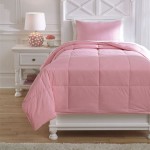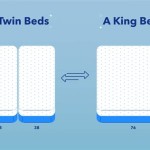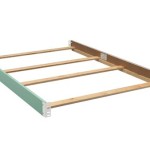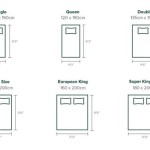What is the Order of Bed Sizes? A Comprehensive Guide
Understanding the standard order of bed sizes is crucial for anyone furnishing a bedroom, selecting appropriate bedding, or even planning the layout of a living space. Bed sizes are generally standardized, although slight variations may exist between manufacturers or across different countries. Knowing these standard dimensions allows for informed purchasing decisions and ensures compatibility between beds, bedding (sheets, comforters, duvets), and bedroom furniture.
The following provides a comprehensive overview of the standard bed sizes commonly available, ordered from smallest to largest, including their approximate dimensions and typical applications. Note that dimensions are typically given in inches in the United States and in centimeters in many other parts of the world. These conversions provided below are approximate. It is important to consult the manufacturer’s specifications for precise measurements.
1. Crib Size
The crib is the smallest standard mattress size, designed specifically for infants and young toddlers. A standard crib mattress measures approximately 28 inches wide by 52 inches long (71 cm x 132 cm). These dimensions are regulated to ensure safety and minimize the risk of infants becoming trapped between the mattress and the crib frame.
Crib mattresses are typically made of either innerspring coils or foam, and are available in varying degrees of firmness. Firmness is a critical factor for infant safety, as a firmer mattress reduces the risk of sudden infant death syndrome (SIDS). Standard crib mattresses should fit snugly inside the crib frame, with no more than two fingers’ width between the mattress and the crib sides.
Given its small size, the crib is exclusively used for infants and toddlers, typically up to the age of two or three years. Once a child outgrows the crib, usually based on height and the ability to climb out, they are typically transitioned to a larger bed, such as a toddler bed or a twin bed.
2. Toddler Bed Size
Toddler beds are designed as an intermediate step between a crib and a full-sized bed. They are typically the same size as a crib mattress (approximately 28 inches wide by 52 inches long – 71 cm x 132 cm), but are lower to the ground and often have safety rails to prevent children from falling out during the night.
The primary advantage of a toddler bed is that it allows young children to transition to a bed that is more accessible and age-appropriate than a standard bed, while still providing a sense of security and comfort. Toddler beds often feature designs and themes that appeal to young children, such as cartoon characters or bright colors.
While the mattress size is identical to a crib mattress, toddler beds typically have a different frame construction and aesthetic. Some cribs are designed to convert into toddler beds, providing a cost-effective and convenient option for parents. The transition to a toddler bed usually occurs when a child starts attempting to climb out of the crib, or when parents feel the child is ready for a more independent sleeping arrangement.
3. Twin Size
A twin bed, also known as a single bed, is the smallest standard bed size suitable for adults and older children. It measures approximately 38 inches wide by 75 inches long (97 cm x 191 cm). Twin beds are commonly used in children's rooms, guest rooms, and smaller bedrooms where space is limited.
Twin beds are a versatile option, suitable for both solo sleepers and for bunk beds, which are often used in shared children's rooms. They are also a popular choice for daybeds, providing seating during the day and a sleeping surface at night. Twin mattresses are widely available in a variety of materials and firmness levels, catering to different sleep preferences and budgets.
The dimensions of a twin bed make it a practical choice for individuals who sleep alone and do not require a larger sleeping surface. They are also relatively easy to move and transport, making them a good option for apartment living or temporary housing situations.
4. Twin XL Size
A Twin XL bed is an extended version of the standard twin bed, offering additional length for taller individuals. It measures approximately 38 inches wide by 80 inches long (97 cm x 203 cm). The extra length (5 inches) makes it particularly suitable for college dormitories, where space is often limited and students may be taller than average.
The width of a Twin XL bed is the same as a standard twin, allowing it to fit in the same room layouts. However, the added length provides significantly more legroom and overall comfort for taller sleepers. Twin XL mattresses are commonly used in college residence halls because they can accommodate a wider range of student heights.
While not as widely available as standard twin mattresses, Twin XL mattresses can be found at most major mattress retailers. Bedding for Twin XL beds, such as sheets and comforters, is also specifically designed to fit the longer dimensions.
5. Full Size
The full size bed, also known as a double bed, provides more sleeping space than a twin bed, making it a comfortable option for single adults or couples who prefer a smaller sleeping surface. It measures approximately 53 inches wide by 75 inches long (135 cm x 191 cm). Full size beds offer a compromise between the space-saving benefits of a twin bed and the increased sleeping area of a queen or king bed.
Full size beds are often used in guest rooms, smaller master bedrooms, and for teenagers transitioning from a twin bed. They can comfortably accommodate one adult with ample room to move around, and can also accommodate two adults who do not mind sleeping close together.
The term "double bed" originated from the fact that it is approximately twice the width of a twin bed. However, it is not quite wide enough to comfortably accommodate two adults with the same level of personal space as a queen or king bed. Full size mattresses and bedding are widely available and typically more affordable than larger sizes.
6. Queen Size
The queen size bed is one of the most popular bed sizes, offering a balance of comfort and space efficiency. It measures approximately 60 inches wide by 80 inches long (152 cm x 203 cm). Queen beds are a suitable choice for couples, single sleepers who prefer extra space, and master bedrooms with limited square footage.
The queen size bed provides ample room for two adults to sleep comfortably without feeling cramped. It is also a good option for individuals who tend to move around a lot during the night. Queen size mattresses and bedding are widely available in a vast array of styles, materials, and price points.
Due to its popularity, the queen size bed is considered a standard for many furniture manufacturers. It offers a comfortable sleeping surface without taking up excessive space in the bedroom. The queen size is a versatile option that works well in various bedroom sizes and layouts.
7. King Size
The king size bed is one of the largest standard bed sizes, offering ample sleeping space for couples who value personal space and comfort. It measures approximately 76 inches wide by 80 inches long (193 cm x 203 cm). King size beds are typically found in master bedrooms and larger guest rooms.
The width of a king size bed allows two adults to sleep comfortably with plenty of room to stretch out without disturbing each other. It is also a suitable choice for families who co-sleep with young children. King size mattresses are often more expensive than smaller sizes, and require larger rooms to accommodate their dimensions.
There are two main types of king size beds: the standard king and the California king. While both are the same overall area, they differ in dimensions.
8. California King Size
The California king size bed is another large bed option, but it is longer and narrower than a standard king bed. It measures approximately 72 inches wide by 84 inches long (183 cm x 213 cm). California king beds are specifically designed for taller individuals who need extra legroom.
While not as wide as a standard king bed, the additional length of a California king bed provides crucial comfort for taller sleepers. It is often a preferred choice for individuals over six feet tall. California king mattresses and bedding are generally more difficult to find than standard king sizes, but are readily available from many online and specialty mattress retailers.
The California king bed is a good option for those who prioritize length over width, or for bedrooms that are narrower but longer. It is important to consider the dimensions of the bedroom when choosing between a standard king and a California king to ensure the bed fits comfortably within the space.
Understanding the order of bed sizes is a crucial first step when determining the best option for a given individual or space. Knowing the dimensions and typical applications of each size allows for more informed decisions regarding mattress purchases, bedding selection, and bedroom layout planning. Considerations such as individual height, sleeping habits, and available space should all be factored into the final decision.

Mattress Sizes And Dimensions Guide Sleep Junkie

Bed Sizes From Smallest To Largest Dimensions Guide

Bed Sizes In Order The Er S Guide Blog

Bed Sizes Specification Dimensions King Size

Bed Sizes Uk Guide To Mattress In Order John Ryan By Design

Mattress Sizes Bed Dimensions Naplab

Mattress Sizes Life Of A Cuddlebit

Tamanhos Cama E Colchão Qual A Medida Ideal

How To Order A Quilt And The Process Works

King Size Cot Dimensions In Inches Top








